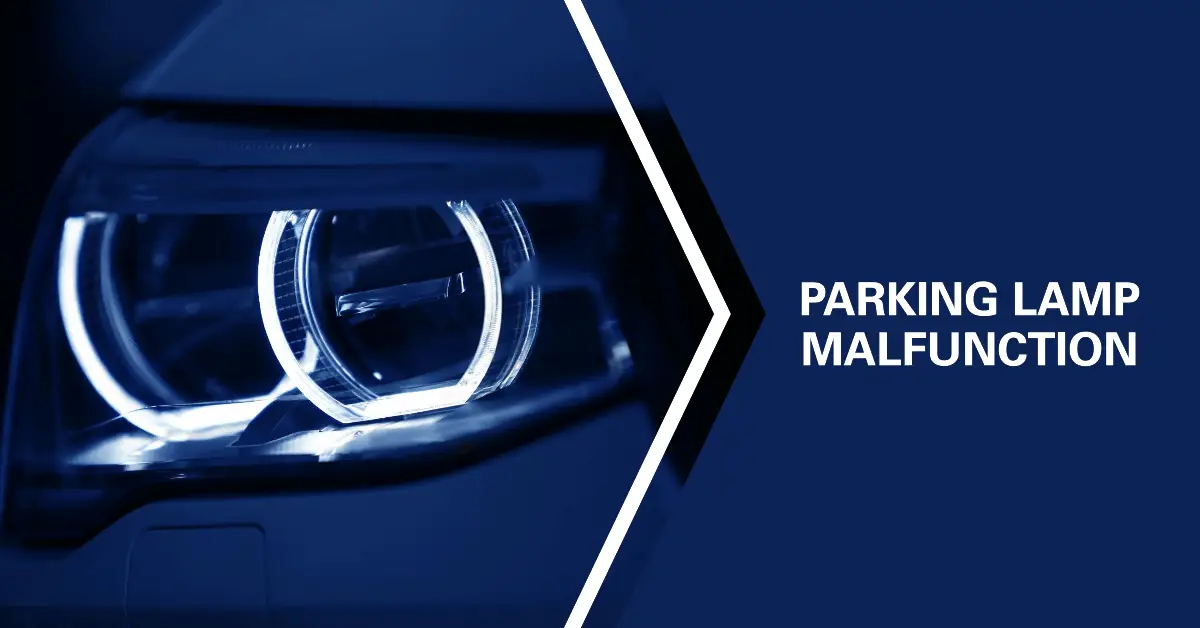Parking Lamp Malfunction in BMW: Top 5 Causes and Expert Solutions
The sight of the dreaded parking lamp warning light striking fear into the hearts of BMW owners is all too common. While a minor nuisance to some, a malfunctioning parking light can be detrimental to daily driving for others. But don’t panic. With some perseverance and investigative work, you can uncover the root cause and restore your BMW’s exterior lighting to its former glory.
This comprehensive guide will explore the ins and outs of parking lamp failures – from symptoms to diagnoses to repairs. You’ll gain a deeper understanding of parking lamp components, learn how to conduct DIY troubleshooting, and discover expert tips for solving the problem once and for all. Consider this your flashlight cutting through the darkness of that pesky parking lamp malfunction. Read on to uncover the top 5 causes and proven solutions to fix parking lamp failure in BMW models.
We’ll examine key questions like:
- What does the parking lamp warning indicator mean?
- What are the most common causes of parking lamp malfunctions?
- How can I diagnose the root cause myself?
- What replacement parts or repairs are needed to fix it?
- What costs am I looking at for repairs?
Arm yourself with the insider knowledge to banish parking lamp problems from your BMW for good. Let’s get started shining some light on this frustrating issue.
What Are Parking Lamps in BMW Vehicles?
Before diving into malfunctions, it helps to understand precisely what parking lamps are in BMWs.
Parking lamps, also called side marker lamps, are the front and rear exterior lights that illuminate when the vehicle is parked or idling with the engine on.
The parking lamps include:
- Front daytime running lights – Located in the headlight housings, these LED strips offer enhanced visibility of your vehicle to other drivers during daytime driving.
- Front side marker lights – Amber lights mounted on the headlight assembly that identify the width of your vehicle when parked.
- Rear tail lights – Red rear lamps that illuminate when the parking brake is engaged or headlights are on. They mark the rear dimensions of your parked car.
Parking lamps provide crucial visibility both for your vehicle and for other cars sharing the road or parking lot. When these lights fail, it not only looks bad, but it creates unsafe driving conditions.
That’s why the parking lamp malfunction indicator light is not one to ignore. Let’s look at what triggers this warning.
What Does the Parking Lamp Malfunction Warning Light Mean?
When you turn your BMW’s ignition on, a quick bulb check will illuminate the parking lamp warning light momentarily. But if it stays lit after engine start or illuminates during driving, it signifies an issue.
The parking lamp malfunction indicator is triggered when one or more of the following exterior bulbs cease to operate:
- Front daytime running lights
- Front side marker lights
- Rear tail lights
Basically, this symbol indicates that an exterior light on your BMW has burned out or failed. The malfunction indicator will remain lit on your instrument cluster until the problem is fixed.
Keep in mind the parking lamp malfunction light is different than the check engine light. While both problematic, the check engine light indicates issues with engine systems rather than exterior lighting.
Now that you know the meaning behind the parking lamp warning, let’s explore the most common reasons these crucial lights stop working properly.
Top 5 Causes of Parking Light Malfunctions in BMWs
Many components work in harmony to power your BMW’s exterior lighting. If one piece fails, it can render the whole system inoperative.
Here are the 5 most common causes of parking light malfunctions:
1. Burned Out Bulb
The simplest and most likely root of parking lamp failure is a plain old burned out bulb. All bulbs eventually burn out over time.
As LED and halogen bulbs age, the filament inside weakens and breaks. They can burn out prematurely due to voltage surges or vibrations.
If you notice the parking lamp warning shortly after replacing a bulb, chances are the new bulb was defective.
Burned out bulbs account for a majority of parking lamp malfunctions. But it’s important to still check other components before assuming a bad bulb is the culprit.
2. Faulty Ballast or Controller
If your BMW uses Xenon or LED headlights, malfunctions most often stem from problems with the ballast or controller.
The ballast regulates electrical current to power Xenon bulbs. Ballast failures can disable one or both headlights. Bad solder connections inside the ballast due to overheating are often the root cause.
LED controllers ensure communication between the light assemblies and the car’s computer. Controller malfunctions can turn off LED arrays in the headlights or daytime running lights. Faulty internal components prevent proper operation.
Most ballast or controller issues require replacement of the entire unit. However, technicians can sometimes repair solder connections in defective ballasts to fix the problem.
3. Damaged Connector or Wiring
Another common source of parking lamp problems is damage along the exterior lighting circuit.
Issues in the wiring or connectors can interrupt the vital flow of electricity. Some examples include:
- Frayed, broken, or pinched wires – Damage along the wire circuit impedes energy transfer to the bulbs. Inspect for cracking, bare wires, and pinching.
- Corroded connections – Moisture and road grime can corrode electrical terminals causing high resistance. Spray connections with electrical contact cleaner.
- Loose connectors – Vibrations can loosen connectors interrupting the circuit. Unplug and replug connectors to refresh the connection.
- Ground failures – Bad vehicle grounding prevents energy return after the bulb. Check ground points are corrosion-free.
Even minor wiring or connector issues can have profound effects on the operation of parking lamps. Carefully inspecting the condition of electrical circuits is an important troubleshooting step.
4. Failed Headlight Switch
One easy-to- overlook cause of parking lamp failure is the headlight switch itself. This key component activates both the headlights and parking lights when toggled.
If the switch internals fail or the contacts wear out, power will not be able to flow to the exterior lights. This prevents the parking lamps from turning on even if bulbs and wiring are fine.
Testing the switch with a multimeter and toggling between off and parking lamp mode can diagnose switch failure. Catching a bad headlight switch early provides an easy fix to restore operation.
5. Faulty Body Control Module
Behind the scenes, your BMW’s body control module (BCM) acts as the brains for managing exterior and interior lighting functions.
The BCM controls electrical loads and relays power to components based on switch inputs. If the BCM suffers an internal failure, it can no longer send control signals to activate the parking lamps.
Problems with the light module, which controls lighting specifically, can also impact the parking lights. Fault code diagnosis and module testing is needed to pinpoint if the BCM or light module is the culprit.
While not the most convenient problem to fix, module replacement can reliably get your parking lamps shining once again.
As you can see, parking lamp operation depends on the synchronization of bulbs, wiring, switches, and control modules. If one piece fails, the whole system suffers.
Now that you’re familiar with the anatomy of potential problems, let’s go over some best practices on how to diagnose parking lamp failure in your BMW.
How to Diagnose Parking Lamp Malfunction?
Accurately diagnosing the root cause of your parking lamp issues is half the battle toward fixing them. Here are some smart tips for testing and troubleshooting:
- Inspect bulbs first – Start simple by visually checking all exterior lighting bulbs. Look for darkened or broken filaments. Replace any bulbs that appear damaged.
- Check fuses – Make sure the parking lamp fuses are not blown. Also inspect any other fuses related to exterior lighting. Replace any blown fuses.
- Perform bulb socket test – Use a multimeter or test light to check for power at the bulb sockets. No power could indicate a switch, wiring, or module issue.
- Wiggle test connections – Wiggle wiring harnesses and connectors while monitoring lights. If lights flicker, you have a loose connection.
- Look for damage – Thoroughly inspect all wiring and connectors for damage. Repair or replace any cracked, corroded, or frayed wires.
- Read fault codes – Use a BMW diagnostic scan tool to read module fault codes related to exterior lighting failures. This can directly point to the problem component.
Following logical diagnostic steps will reveal whether the malfunction is from a simple bulb outage or more complex electrical issue. Let’s now look at the specific repairs and parts needed to get your parking lights operational again.
Expert Tips for Fixing Parking Lamp Malfunction
Once you’ve diagnosed the specific cause of the problem, it’s time to carry out the proper repairs to get your BMW’s parking lamps glowing vibrantly once more.
Here are expert-recommended tips to complete the fix:
- Always replace burnt bulbs with OEM – For the best performance and longevity, use genuine BMW bulbs for any replacements. Aftermarket bulbs can have shorter lifespan.
- Carefully inspect before reinstalling – When reinstalling a lamp assembly, closely examine for damage. Replace any cracked lenses or housings.
- Clean electrical contacts – Use electrical contact cleaner spray to clean any dirty or corroded wiring terminals and ground points.
- Follow manufacturer procedures – Consult BMW service manuals and resources for proper lamp assembly removal and installation.
- Test thoroughly after repairs – Complete full functional tests of lights and electronics to ensure the parking lamps are fully operational.
- Consider professional help – For complex electrical issues or module repairs, it may be best to enlist an experienced BMW technician.
With consistent inspection and high-quality replacements, you can feel confident the parking lamp problems will stay fixed long-term.
Repairing the various parking lamp malfunction causes does require some investment. Let’s examine the typical costs involved.
How Much Does It Cost to Fix Parking Light Malfunction?
Expect to pay anywhere from $50 up to $300+ to properly fix your BMW’s parking lamp issues. Cost depends on factors like:
- If merely replacing a bulb
- Number of bulbs needing replacement
- Part costs for new controller, ballast, switch, or module
- Labor at an auto repair shop
- Extent of any electrical wiring repairs needed
Just replacing a single burnt out bulb could cost as little as $50 if you do it yourself. However, replacing a bad Xeno headlamp ballast could run over $200 or more just for the part. Complex module repairs can cost up to $300 in total or greater when accounting for labor.
And remember – putting off the repair for too long may lead to getting pulled over for the expired tag light. Plus continually driving with limited exterior lighting is a significant safety hazard.
Making the investment to fix parking lamp failure promptly pays dividends through restored visibility, improved safety, and peace of mind from a fully operational lighting system. The functionality and added vehicle value gained outweighs the temporary pain to your wallet.
Is It Safe to Drive with Parking Lamp Malfunction?
You might be wondering – can you still drive while the parking lamp warning light is on? Let’s look at the safety considerations:
- Technically yes – a parking lamp malfunction itself does not make the vehicle undriveable. However…
- Loss of exterior lighting decreases safety – Reduced visibility of your car to other drivers increases accident risk, especially at night.
- Potential for bigger problems – Driving with damaged wiring or malfunctioning electronics can worsen issues.
- You may get ticketed – Police can pull you over and ticket you for burnt out lights and other parking lamp violations.
While you can drive with parking lamps malfunctioning, it is recommended you limit driving only to essential trips before repairs. And always replace burnt out headlight bulbs immediately before operating the vehicle.
The best course of action is to promptly diagnose the failure cause and complete repairs to restore normal exterior lighting function. Don’t unnecessarily endanger yourself and others on the road by delaying the fix.
Now that you’re armed with knowledge for successfully troubleshooting and repairing parking lamp problems, it’s time to put that know-how into action. Let’s summarize the key points:
Summary – How to Fix BMW Parking Lamp Malfunction
Follow this streamlined process when your BMW parking lamps fail:
- Diagnose – Inspect bulbs, wiring, switches, modules to identify root cause.
- Repair – Based on diagnosed cause, replace burnt bulbs, damaged wires, faulty components.
- Verify – Complete full functional test to confirm normal operation restored.
- Prevent – Check parking lamps regularly to catch issues early.
- Enlist help – For complex electrical issues, work with a qualified BMW technician.
With the right diagnosis and high quality repairs, you can eliminate those pesky parking lamp malfunctions for good. Use the guidance in this guide to illuminate the problem and enjoy the satisfaction of DIY success.
Your BMW’s parking lamps are some of the most important safety components you depend on daily. Don’t settle for lackluster exterior lighting plagued by continual failures. Leverage the in-depth troubleshooting and repair information presented here to reclaim your driving confidence and nighttime road visibility.
The next time you see that parking lamp warning indicator lit up, smile knowing you have the knowledge to extinguish it for good. Go forth into the night brightly and safely once again!







